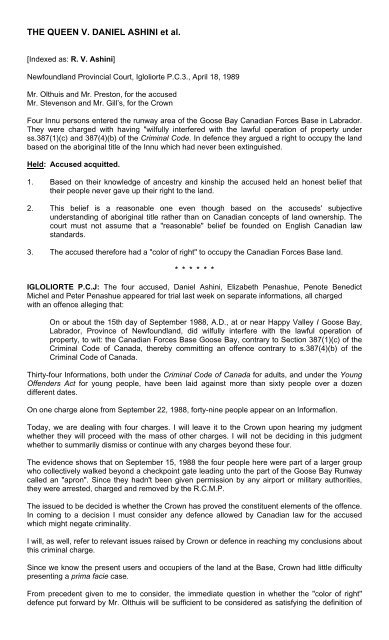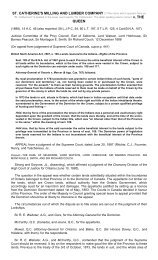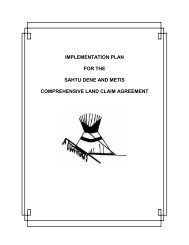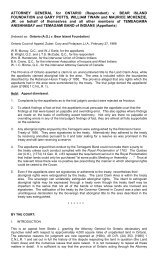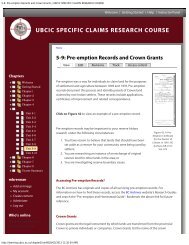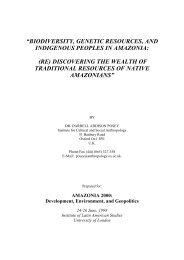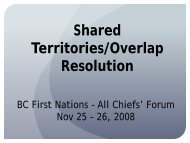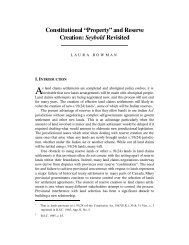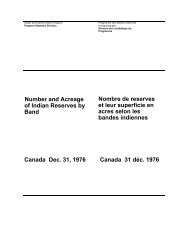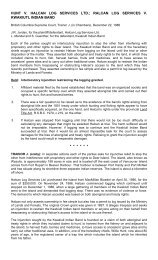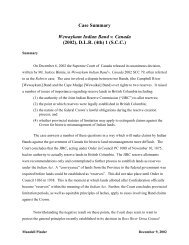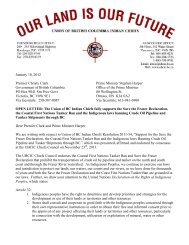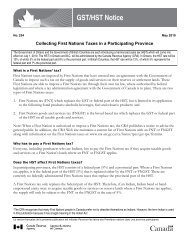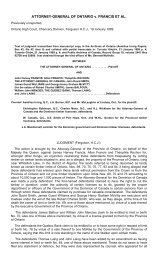THE QUEEN V. DANIEL ASHINI et al.
THE QUEEN V. DANIEL ASHINI et al.
THE QUEEN V. DANIEL ASHINI et al.
Create successful ePaper yourself
Turn your PDF publications into a flip-book with our unique Google optimized e-Paper software.
<strong>THE</strong> <strong>QUEEN</strong> V. <strong>DANIEL</strong> <strong>ASHINI</strong> <strong>et</strong> <strong>al</strong>.[Indexed as: R. V. Ashini]Newfoundland Provinci<strong>al</strong> Court, Igloliorte P.C.3., April 18, 1989Mr. Olthuis and Mr. Preston, for the accusedMr. Stevenson and Mr. Gill’s, for the CrownFour Innu persons entered the runway area of the Goose Bay Canadian Forces Base in Labrador.They were charged with having "wilfully interfered with the lawful operation of property underss.387(1)(c) and 387(4)(b) of the Crimin<strong>al</strong> Code. In defence they argued a right to occupy the landbased on the aborigin<strong>al</strong> title of the Innu which had never been extinguished.Held: Accused acquitted.1. Based on their knowledge of ancestry and kinship the accused held an honest belief thattheir people never gave up their right to the land.2. This belief is a reasonable one even though based on the accuseds' subjectiveunderstanding of aborigin<strong>al</strong> title rather than on Canadian concepts of land ownership. Thecourt must not assume that a "reasonable" belief be founded on English Canadian lawstandards.3. The accused therefore had a "color of right" to occupy the Canadian Forces Base land.* * * * * *IGLOLIORTE P.C.J: The four accused, Daniel Ashini, Elizab<strong>et</strong>h Penashue, Penote BenedictMichel and P<strong>et</strong>er Penashue appeared for tri<strong>al</strong> last week on separate informations, <strong>al</strong>l chargedwith an offence <strong>al</strong>leging that:On or about the 15th day of September 1988, A.D., at or near Happy V<strong>al</strong>ley I Goose Bay,Labrador, Province of Newfoundland, did wilfully interfere with the lawful operation ofproperty, to wit: the Canadian Forces Base Goose Bay, contrary to Section 387(1)(c) of theCrimin<strong>al</strong> Code of Canada, thereby committing an offence contrary to s.387(4)(b) of theCrimin<strong>al</strong> Code of Canada.Thirty-four Informations, both under the Crimin<strong>al</strong> Code of Canada for adults, and under the YoungOffenders Act for young people, have been laid against more than sixty people over a dozendifferent dates.On one charge <strong>al</strong>one from September 22, 1988, forty-nine people appear on an Informafion.Today, we are de<strong>al</strong>ing with four charges. I will leave it to the Crown upon hearing my judgmentwh<strong>et</strong>her they will proceed with the mass of other charges. I will not be deciding in this judgmentwh<strong>et</strong>her to summarily dismiss or continue with any charges beyond these four.The evidence shows that on September 15, 1988 the four people here were part of a larger groupwho collectively w<strong>al</strong>ked beyond a checkpoint gate leading unto the part of the Goose Bay Runwayc<strong>al</strong>led an "apron". Since they hadn't been given permission by any airport or military authorities,they were arrested, charged and removed by the R.C.M.P.The issued to be decided is wh<strong>et</strong>her the Crown has proved the constituent elements of the offence.In coming to a decision I must consider any defence <strong>al</strong>lowed by Canadian law for the accusedwhich might negate crimin<strong>al</strong>ity.I will, as well, refer to relevant issues raised by Crown or defence in reaching my conclusions aboutthis crimin<strong>al</strong> charge.Since we know the present users and occupiers of the land at the Base, Crown had little difficultypresenting a prima facie case.From precedent given to me to consider, the immediate question in wh<strong>et</strong>her the "color of right"defence put forward by Mr. Olthuis will be sufficient to be considered as satisfying the definition of
"an honest belief in a state of facts, which if it existed, would be a leg<strong>al</strong> justification or excuse."Creaghan, p.453.In my opinion, Mr. Olthuis has presented a v<strong>al</strong>id defence and <strong>al</strong>so a successful one. We are notde<strong>al</strong>ing with any land which has been the subject of divestiture through treaties, as under theIndian Act, R.S.C. 1970, c.I-6. Each of these four persons based their belief of ownership on anhonest belief on reasonable grounds. Through their knowledge of ancestry and kinship they haveshowed that none of their people ever gave away rights to the land to Canada, and this is anhonest belief each person holds. The provinci<strong>al</strong> and feder<strong>al</strong> statutes do not include as third partiesor signatories any Innu people. I am satisfied that the four believe their ancestors predate anyCanadian claims to ancestry on this land.Since the concept of land as property is a concept foreign to origin<strong>al</strong> people the Court must notassume that a "reasonable" belief be founded on English and hence Canadian law standards. TheInnu must be <strong>al</strong>lowed to express their understanding of a foreign concept on their terms, or simplyexpress what they believe.The Crown has presented to me recent cases such as Baker Lake [Haml<strong>et</strong> of Baker Lake <strong>et</strong> <strong>al</strong>. v.Mm. of Indian Affairs and Nor. Dev. <strong>et</strong> <strong>al</strong>., [1979] 3 C.N.L.R.17, [1980] 1 F.C. 518 (F.C.T.D.)] andC<strong>al</strong>der [C<strong>al</strong>der v. A.G.B.C. (1973), 34 D.L.R. (3d) 145 (S.C.C.)] which only emphasize the conceptof land as property from an English law viewpoint. Like the I.Q. tests administered to schoolchildren some years ago which simply reflects the understanding of the maker of the test, not theperson being tested, there is an inherent bias. For example, in C<strong>al</strong>der, the reference to "properlyconstituted authorities" is a justification of a Proclamation. It assumes that origin<strong>al</strong> inhabitantsaccepted this Proclamation and agreed that it extinguished their interests as users from a timewhich predated the appearance of Europeans.These four people have shown me their belief in owner's rights is unshaken by the presentoccupation.All of the leg<strong>al</strong> reasonings are based on the premise that somehow the Crown acquired magic<strong>al</strong>lyby its own declaration of title to the fee a consequent fiduciary obligation to the origin<strong>al</strong> people. It istime this premise based on 17th century reasoning be questioned in the light of 21St centuryre<strong>al</strong>ity.Canada is a vit<strong>al</strong> part of the glob<strong>al</strong> village and must show its maturity not only to the segment ofCanadian soci<strong>et</strong>y that wields great power and authority to summarily affect the lives of minoritygroups with the flourish of a pen to y<strong>et</strong> another "agreement" or "memorandum of understanding"resulting in great soci<strong>al</strong> and economic benefit; but <strong>al</strong>so to its most desperate people.The forty year history of these Innu people is a glaring reminder that integration or assimilation<strong>al</strong>one will not make them a he<strong>al</strong>thy community.By declaring these Innu as crimin<strong>al</strong>s for crying enough the Court will be have been unable torecognize the fundament<strong>al</strong> right to <strong>al</strong>l persons to be treated equ<strong>al</strong>ly before the law.Both s<strong>et</strong>s of the foregoing reasons are sufficient, in my mind, to have these four acquitted of anywrongdoing under s.387 of the Crimin<strong>al</strong> Code of Canada.Fin<strong>al</strong>ly, the parties will have to negotiate answers to their problems, since the Court is unable toanswer these problems for them.


